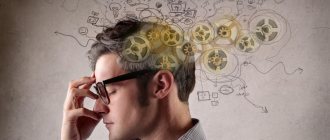Thinking is one of the forms of higher mental activity of a person. With the help of various senses, we receive certain information about the environment, but it is the mental processes that allow us to evaluate and analyze it, make plans for the near future, and set certain life goals. Thinking disorders are one of the first and key symptoms of many mental illnesses; it is because of this that a person gradually loses his ability to work, and sometimes the ability to perform even simple everyday skills. Therefore, the doctors at the Leto mental health center determine the treatment tactics for such disorders taking into account their root cause.
Etiology
Thinking is a single process in which both hemispheres participate. The speech center is located in the left; it provides a logical analysis of objects and phenomena based on signals received from the senses. Thanks to this, a person forms a certain opinion about a particular situation. The right hemisphere is responsible for the emergence of emotional and sensory images. They cannot always be expressed verbally; sometimes they are described as intuition, subconscious, etc.
Therefore, almost any neurological disease affects perception processes in one way or another. The most common causes of thought disorders include:
- epilepsy;
- acute and chronic infections that occur with complications on the central nervous system (encephalitis, meningitis, syphilis, undiagnosed or decompensated form of HIV/AIDS), parasitic infestations;
- neoplasms in the brain: cysts, vascular aneurysms, benign or malignant tumors;
- previous strokes;
- dyscirculatory encephalopathy;
- brain damage due to liver dysfunction;
- consequences of traumatic brain injuries;
- deficiency of B vitamins, folic acid, severe metabolic disorders.
Sometimes the syndrome is associated with genetic defects in the production of basic neurotransmitters and the formation of neuronal connections. In such cases, the symptoms of the disease manifest themselves either at an early age with speech delays, problems with the formation of logical associations, or in adults in combination with severe mental disorders.
Thinking disorders are typical for:
- schizophrenia;
- almost all forms of psychopathy;
- dementia;
- Alzheimer's disease;
- autism;
- oligophrenia;
- acute and chronic psychoses.
The syndrome may also be accompanied by depression and other affective disorders, anxiety and phobic neurosis. In such cases, the pathology is acquired. Such changes occur under the influence of stressful and traumatic factors.
How do specialists work?
Our clinic employs experienced specialists who know how to effectively approach solving these problems. The patient is given training, after which memory, attention and thinking are strengthened. Modern tests focus on word repetition; drawing up a single picture from several abstract concepts; text analysis; solving problems using ingenuity.
If necessary, specialists will select a complex of vitamins and medications necessary to eliminate the problem, which are selected individually, depending on the cause and stage of manifestation of the disorders.
The goal of our specialists is to develop a set of measures to restore vital functions. We strive to completely change the patient’s lifestyle, making it the most favorable for recovery.
Clinical features
In foreign psychiatry there is no unified classification of thinking disorders, since they are considered in the structure of other diseases. Domestic specialists prefer to work with a fairly simple classification that accurately reflects all the features of the syndrome. In accordance with it, the following forms of the disease are distinguished:
- dynamic: changing the pace of thinking;
- structural, associated with a violation of the logical sequence of thoughts, the ability to perform consistent, planned actions;
- pathologies of judgment, in which the patient cannot adequately assess what is happening around.
Dynamic thought disorders
This group includes:
- Lethargy. Accompanied by a slowdown in the train of thought, and as a result, speech. The patient prefers simple, monosyllabic sentences, as if constantly searching for words. The reaction speed decreases, the ability to systematize information deteriorates or is completely absent.
- Acceleration of thought processes. The pace of thinking increases many times over, but at the same time the person is unable to concentrate on anything, constantly “jumping” from one thing to another, but does not bring anything to its logical conclusion.
- "Jump" of thoughts. In the patient’s head, thoughts change so quickly that they resemble a kaleidoscope; he does not even have time to voice them, which is why his speeches are often called “verbal hash.”
Such forms of the syndrome are characteristic of mania, schizophrenia, and depression.
Structural thinking disorders
The following syndromes include:
- Dissociation. Characteristic is the absence of a logical connection between individual judgments while maintaining consciousness.
- Incoherence. The person is completely disoriented, unable to focus on anything, speech is meaningless, sometimes it is just a collection of sounds. Usually a symptom of serious organic brain damage.
- Thoroughness. They note a tendency to become fixated on certain details. The patient answers any question in detail and thoroughly, dwelling on completely unnecessary and uninteresting details. The speech is verbose, replete with aphorisms, metaphors, and comparisons.
- Perseveration. The patient is constantly focused on the same thought, and therefore is not able to form new logical associations. This pathological process is also reflected in speech: the patient repeats the same word or phrase for a long time.
- Reasoning. There is no focus on any object. Pay attention to the tendency to fruitless and meaningless reasoning and philosophizing.
- Symbolism. Typically, the desire to give any objects a special meaning (usually negative or frightening), which determines the manner of behavior. For example, the color blue is associated with misfortune, a cut flower with death, etc.
- Autism. Characterized by a lack of connection between thinking and the surrounding reality. The patient forms images and logical chains of conclusions that are understandable only to him alone.
These types of thinking disorders are characteristic of severe mental illness, autism spectrum disorders, and schizoaffective syndrome.
Pathology of judgments
Usually develops against the background of exacerbation of pathologies of the psycho-emotional sphere or with psychosis caused by alcohol or drug use. This variant of the disease can manifest itself:
- Obsessive ideas. These are persistent thoughts that appear against the will of the patient. A person understands their absurdity and inappropriateness, but cannot get rid of them. This syndrome is not accompanied by intellectual impairment, but causes severe anxiety and restlessness, which does not have the best effect on the productivity of thinking and performance.
- Super valuable ideas. They represent judgments formed on the basis of real events, but their meaning for the patient clearly does not correspond to the situation. A striking example of people with super-valuable ideas are religious fanatics who evaluate both their own and others’ actions from the point of view of sinfulness and repentance.
- Delirious. This is a false, distorted, usually ridiculous conclusion that has nothing to do with reality. The plot of delirium is different: from ideas of jealousy and persecution to love experiences.
Why you need to know about cognitive distortions
Errors need to be corrected.
And to do this, they need to be found. Cognitive distortions are cleverly disguised as normal thought processes - it will not occur to anyone that something went wrong in the reasoning. There are many cognitive distortions. Wikipedia lists 175 ways of self-deception - a huge number. Some are somewhat similar, some duplicate each other. It is impossible to learn and know everything all the time, but from time to time it is useful to look through the list of errors, find your favorites and get rid of them.
Cost of services
| CONSULTATIONS OF SPECIALISTS | |
| Initial consultation with a psychiatrist (60 min.) | 6,000 rub. |
| Repeated consultation | 5,000 rub. |
| Consultation with a psychiatrist-narcologist (60 min.) | 5,000 rub. |
| Consultation with a psychologist | 3,500 rub. |
| Consultation with Gromova E.V. (50 minutes) | 12,000 rub. |
| PSYCHOTHERAPY | |
| Psychotherapy (session) | 7,000 rub. |
| Psychotherapy (5 sessions) | 30,000 rub. |
| Psychotherapy (10 sessions) | 60,000 rub. |
| Group psychotherapy (3-7 people) | 3,500 rub. |
| Psychotherapy session with E.V. Gromova (50 minutes) | 12,000 rub. |
This list does not contain all prices for services provided by our clinic. The full price list can be found on the “Prices” , or by calling: 8(969)060-93-93. Initial consultation is FREE!
Why the brain loves to make mistakes
Every distortion is needed for some reason. They appeared during the development of the brain to help a person adapt to the world, not go crazy, and save energy and time.
Buster Benson, a trainer and blogger, spent a month studying and sorting them: he made a table, cleared out duplicates, grouped the main errors. He came up with 20 template scenarios according to which the brain works.
These scripts solve four main problems:
- How to cope with information overload.
- How to act when you don't understand anything.
- How to act quickly.
- How to remember the important and not remember the unnecessary.
Today we will look at cognitive distortions that solve the first problem.
Treatment and diagnosis of thought disorders
Before prescribing treatment, the medical doctor excludes possible functional pathologies of the central nervous system using X-ray or tomographic scanning, examination of cerebral vessels, clinical and laboratory blood tests.
If the syndrome is caused by neurological causes, a highly specialized specialist is invited for consultation. In the absence of organic brain damage, psychosocial testing is performed to determine the specific type of mental illness and its severity.
Treatment directly depends on the diagnosis. Thus, for schizophrenia and psychopathy, neuroleptics and tranquilizers are prescribed, and psychotherapy is only auxiliary and is indicated outside the period of exacerbation. Psychoses require hospitalization and intensive drug treatment. Neuroses and depression respond well to cognitive behavioral therapy.
Thinking disorders are a strict indication for seeing a doctor, and the earlier treatment is started, the higher the likelihood of a favorable prognosis and long-term remission. To consult with a doctor, you must either make an appointment or arrange a specialist home call from our operators by calling 8(969)060-93-93 .
Obsessions in a person
These disorders are otherwise called obsessions. Such thoughts arise involuntarily and constantly occupy a person’s attention. They may contradict his value system and not correspond to his life. Because of them, a person is emotionally exhausted, but cannot do anything about them. Obsessive thoughts and ideas are perceived by a person as their own, but due to the fact that most of them are aggressive, obscene, meaningless, a person suffers from their attack. They can arise due to psychotraumatic situations or organic damage to the prefrontal cortex, basal ganglia, and cingulate gyrus.










